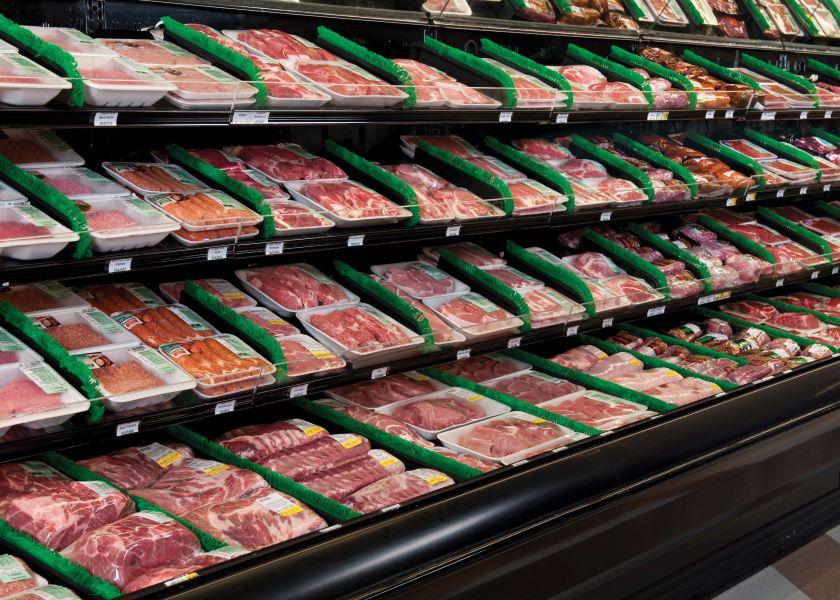Will the Run Up in Retail Meat Prices Continue? USDA Thinks So, Says Consolidation Isn't Fully to Blame

The price shoppers pay for items like meat at the grocery store are expected to continue the rapid rise. An updated Consumer Price Index (CPI) released from USDA Economic Research Service (ERS) shows wholesale beef prices climbed 14.2% from July to August of 2021, and price projections point to a possible 20% increase in wholesale beef prices this year.
The price projections released are for a wide variety of grocery store items. According to Farm Journal Washington Correspondent Jim Wiesemeyer, meat prices are expected to see the largest increase.
The updated ERS forecast shows prices for meats, poultry and fish now sits at 4.5% to 5.5%, which is up from the 4% to 5% posted last month. He says the main drivers are higher beef and pork prices.
“Contributing to the increase is what are now expected to be 6.5% to 7.5% higher beef prices compared with an increase of 4.5% to 6% last month,” reports Wiesemeyer. “Pork prices are now expected to also be up 6.5% to 7.5% from 2020 levels, up slightly from the forecast range in September of 6% to 7%. Poultry prices are forecast to rise 3.5% to 4.5% versus 3% to 4% in September.”
Beef Prices
Wiesemeyer points out beef and veal prices have gone up 6.5% so far this year versus the same period in 2020, with prices in September up 17.6% from year-ago. Pork prices are up 6.3% so far in 2021 versus the same period in 2020. In September, prices were up 12.7% from year ago. One agricultural economist says bacon prices are one of the biggest sticker shock items at the grocery store right now.
“We've certainly seen very strong increases in retail meat prices year over year. One big category is bacon. If you look back at the start of the pandemic compared to now, bacon prices are between 30% and 40% higher today than they were then,” says Jayson Lusk, agricultural economist with Purdue University.
Bacon Prices on the Rise
Lusk says bacon prices have shown sticker shock as of late as bacon is being buoyed by a few factors, including dynamic demand, both domestically and abroad.
“We've been talking about China, and they're buying a lot of meat products. So yes, they're building back their hog herd, but they're buying a lot of meat,” he says. “It's been really strong export demand for our meat products. All the supply cost issues we're talking about that come through to the animals on the feed side, the labor side and the packing plant side, are being reflected in the meat prices, too.”
Is Consolidation in the Meat Industry to Blame?
Economists who compiled the CPI report cited a similar story as to why protein prices are climbing.
“Prices have been driven up by strong domestic and international demand, labor shortages, supply chain disruptions, and high feed and other input costs,” the report said. “Winter storms and drought impacted meat prices this spring, and processing facility closures due to cybersecurity attacks impacted beef and other meat production in May.”
The ERS report reiterated there are a plethora of factors driving the increase in meat prices, not just consolidation in the meat industry.
“Consolidation in the meat industry could also have an effect on prices," the report stated.
Grocery store price forecasts for 2021 were also increased for fish and seafood, eggs and fats and oils compared with the outlook in September. “Low imports, labor shortages, and strong domestic demand, particularly within the foodservice sector, have increased prices,” USDA said.
The ERS report follows recent claims from the Biden administration, with USDA Secretary Tom Vilsack blaming consolidation for the run-up in meat prices at the retail level during a press conference at the White House in September.
"Our job is to make sure the farmer gets a fair price, and that when I go to the grocery store and I’m in the check-out line, I’m paying a fair price and I’m not paying more than I should,” Vilsack told reporters at the White House. “And right now, because of the concentration, we have two issues. One, we have the issue of fairness and two, we have the issue of resiliency. Any one of these facilities, whether it's a cyber-attack or COVID basically shutting down some of Tyson's facilities, it causes disruption in the market."
Economists Disagree
During the 2021 U.S. Farm Report College Roadshow last week, Lusk told U.S. Farm Report he also doesn’t see consolidation being a major factor in the rise in retail meat prices.
“If you look at the overall food CPI, meat has a big weight in that. When meat prices change, it pushes that over overall CPI, so meat prices have been more volatile than many other food items. So, it is true that meat is a big driver of the food CPI. I don't necessarily agree with all the reasons the White House report gave for why meat prices were rising. But it is certainly the case that meat is a big driver of the overall food price inflation that we're seeing,” Lusk told U.S. Farm Report.
Lusk says even with protein prices racing higher at the grocery store, he doesn’t expect the higher prices to scare away the record domestic demand the U.S. has seen so far this year.
According to Wiesemeyer, the ERS report showed prices consumers pay when eating out compared to prices they pay when choosing to eat at home.
“Overall food price inflation is put at 3% to 4% for 2021, with restaurant (food away from home) prices seen rising 3.5% to 4.5% while grocery store (food at home) prices are seen increasing 3.5% to 4.5%. All three forecast ranges are steady with month ago. It takes considerable movement in food price categories to raise the overall food price inflation outlook. USDA has only increased its forecast of all food prices in 2021 twice — June and August — since their initial forecast for a 2% to 3% increase that was issued in July 2020,” Wiesemeyer reported.







